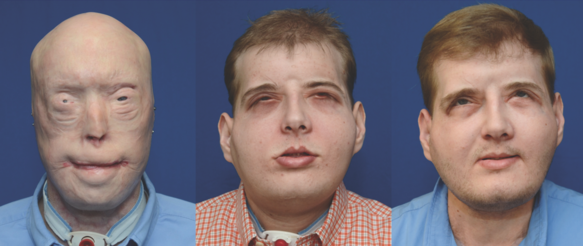Firefighter's Full Facial Transplant Not Covered by Comp, Financial Award Minimal
Monday, September 19, 2016 | 0
On a pleasant late-summer day in 2001, business lagged at Patrick Hardison's small-town Mississippi tire shop. So when an alert sounded on his pager from the Senatobia Fire Department, the volunteer firefighter jumped into his Chevy. He arrived at the firehouse just in time to get a seat on the truck, which rushed to a burning mobile home 15 miles away.
The injuries Hardison sustained that day changed the course of his life. The mobile home's roof caved in on his head, melting his helmet and turning the flesh on his skull to char. He survived, but the injuries devastated him.

Patrick Hardison before surgery, five months after surgery, and one year after surgery.
NYU Langone Medical Center photo
Last year, after living with a severely disfigured face for 14 years, Hardison underwent a full facial transplant. It was the most extensive surgery of its kind ever performed in the United States.
Workers' compensation didn't cover that surgery. And because of Mississippi's lack of a catastrophic claims statute, Hardison's financial award after the injury was minimal.
"In most states that have a catastrophic claims statute, they get paid a different amount or perhaps a greater amount or lifetime amount based on the claim being catastrophic," said Mississippi claimants' attorney Rogen Chhabra. "In Mississippi, we don't have that distinction. The most anybody can get in Mississippi is 450 weeks of benefits."
Hardison said that the system covered only his medical bills.
"I was a volunteer, so I wasn't compensated financially, just my medical bills paid," Hardison said when reached by Facebook message. He declined to comment further.
He did not retain a workers' compensation attorney and did not reach a settlement with his employer, according to the Mississippi Workers' Compensation Commission database.
What comp paid for: medical
Before the face transplant, Hardison underwent 71 surgeries in 14 years. Most were skin grafts, stretching skin taken from his leg over his face and head.
But the surgeries "were unable to return any 'semblance of normal anatomy' to the otherwise normal man, who hid behind sunglasses and a baseball cap whenever he ventured outdoors," as a 2016 state Legislature resolution commending Hardison's bravery put it.
In 2014, Hardison's church friend put him in touch with a surgeon at NYU Langone, a research hospital affiliated with New York University. The surgeon had performed a partial face transplant two years earlier. NYU Langone agreed to operate on Hardison pro bono. The procedure would have cost about $1 million, the surgeon told multiple media outlets.

Location of Senatobia, Miss.
Hardison had the surgery last year. To much fanfare, the surgery went off without a hitch, and Hardison has recovered. He told the dozens of news outlets that covered his story of his relief to regain a normal face.
At the time of Hardison's injury, the City of Senatobia received workers' compensation coverage from a struggling Mississippi insurer, Stoneville Insurance Co.
Stoneville's financial problems seemed to come to a head in spring 2001, when it filed a form with the Securities and Exchange Commission requesting a reprieve from filing responsibilities. (Small insurers usually file Form 15-15D in an attempt to save money.) One month later, its chief financial officer and vice president resigned.
By the time Stoneville received Hardison's claim, it was already in too deep. Stoneville passed the claim to its reinsurer, American Casualty Co. of Reading, Pennsylvania, and liquidated its assets in December 2001 — three months after Hardison's injury.
The City of Senatobia has since joined a risk pool, Mississippi Municipal Service Co. American Casualty Co. continues to manage Hardison's claim via its parent company, CNA Financial Corp.
Representatives of CNA Financial Corp. and the third-party administrator handling the claim, Central Adjustment Co., said they could not speak to claim specifics. It is unclear how many of the 71 surgeries Hardison received were covered by workers comp.
"He's entitled to any surgeries that are reasonably medically necessary, but nothing that's cosmetically necessary," Chhabra said.
During the period when Hardison received the bulk of his surgeries, he had an oxycodone prescription, according to a New York magazine article from last year. He began to depend on the medication. When prescriptions ran out, "he found other ways to procure the painkillers," the story reads. In the late 2000s, he was arrested for forging a prescription and bouncing a check. Around that time, he declared bankruptcy and lost his house.
According to the article, he still receives oxycodone, carefully titrated by doctors "concerned about his past addiction."
What comp paid for: benefits
At the time of his injury, Hardison owned a tire shop in Senatobia. After the injury, he was out of work for many years.
He lived off a federal disability check for $1,200 a month and some funds from a private insurance policy, according to media reports. He and his former wife, Chrissi, lost their home and cars, and moved in with Chrissi's mother.
According to the New York magazine article, he received a weekly workers' compensation benefit, but it was "based on his earnings as a firefighter — $15 per fire."
That likely means he received the state's minimum weekly benefit of $25 per week, standard practice for volunteer firefighters, said Mississippi Firefighters Association President John Pope.
"If you had a volunteer fireman that had a job and gets injured on a fire scene, workers' comp benefits are not going to be based on what his employer pays him," Pope said. "He would receive the minimum base rate if he was not employed by a fire department full-time."
For volunteer firefighters in this situation, Mississippi's Office of the Attorney General maintains a fund called the Law Enforcement Officers and Firefighters' Disability Benefits Trust Fund, Pope said. The fund provides the injured worker with a monthly disability payment of 34% of his or her salary, with adjustments if the person also receives workers' compensation benefits, according to the Attorney General's office's website.
But the fund came into being in 2007 — long after Hardison's accident — and it does not cover injuries that occurred before that date, an Attorney General's office representative said when reached by phone.
If Hardison had been injured one state away, in Alabama, his workers' compensation claim likely would have been governed by the state's catastrophic claims statute, Chhabra said.
In Mississippi, "we don't have a catastrophic multiplier or enhancer type statute, and it's really egregious in a case like this where a guy's had his face burned off," Chhabra said. "He's living a life completely different than the one he lived before."
Chhabra said he wishes Hardison had gotten a lawyer.
"It's so sad to hear people like that didn't have a lawyer," Chhabra said. "You can talk to a lawyer for free."






Comments